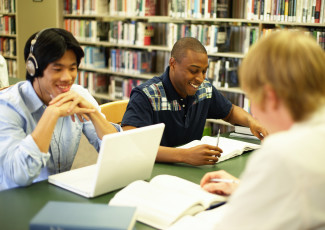Outreach to High Schools Yields Results
By AACC Staff
January 13, 2016
Community colleges connect with high school counselors and students to improve enrollment and completion numbers.
The following excerpt of an article written by Ellie Ashford originally appeared at Community College Daily.
Reaching out to high schools takes a lot of extra work for community colleges, but college officials who make the effort find it can pay off in higher enrollment and completion rates.
At Bakersfield College (BC) in California, which carries out several outreach activities, for example, about 95 percent of first-time students are recent high school graduates, and that number is growing, says Steve Watkin, director of outreach and school relations.
The college invites about 100 counselors from 40 local high schools to an annual fall conference aimed at strengthening relationships and offering opportunities for collaboration. BC also hosts a breakfast for high school principals, outreach sessions targeted to African-American and Latino high school students, a biannual summit for K-14 math educators and gives presentations at high school parent nights on the college application process.
At these sessions, BC stresses the importance of having high school seniors develop an abbreviated student education plan for the first semester, Watkin says. Students who complete a plan get priority when registering for classes at BC.
“When students come in with a plan, they are more likely to successfully complete the first semester and enroll in the second semester,” Watkin says. “We’re trying to get them engaged, to get on a pathway before they graduate from high school.”
Engaging underserved groups
BC also makes a special effort to encourage African-American and Latino middle and high school students to get on a college-going pathway, says Odella Johnson, equity and inclusion director. The college works with the Kern Community Foundation on realigning coursework, programs and practices to engage student populations that have been historically underserved and underrepresented in higher education, she says.
Those students “bring a whole different mindset to campus,” Johnson notes. “Students who would be the first in their families to attend college are at a disadvantage if they don’t have parents who can talk about this in real, practical ways.” These students often don’t have computers or internet access at home and don’t know how to talk to faculty.
“We want students to be focused and directed,” Johnson says. And that means educating parents about the demands of higher education. Students need plenty of time to study, so they shouldn’t be have to take care of younger siblings, she says.
Johnson takes every opportunity possible to talk about these issues. For example, she’s been invited to speak at an upcoming community meeting on human trafficking and will talk about the importance of preparing for college as way to keep youths out of trouble.
Fun with STEM
Scottsdale Community College (SCC) in Arizona engages high school students and their teachers at an annual Math Science Field Day. About 300 high-achieving students from 16 area high schools will take part in academic competitions this month at the college with scholarships awarded to nine winners.
During the morning, students take math and science tests, participate in a team competition and explore demonstrations by college faculty in biology, forensics, robotics, physics, chemistry and other STEM (science, technology, engineering and math) fields. In the afternoon, teams from each school take part in a hands-on engineering competition; last year they built rockets that power air cannons. Then there’s a final Jeopardy-style quiz on stage, followed by an awards ceremony.
While students compete, college faculty engage with their teachers on STEM-related activities, such as tours of geological sites on campus or presentations on robotics or birds of prey rehabilitation.
The event gives high school teachers an opportunity “to know us, trust us and learn about our programs,” says math professor Patricia Dueck. As a result, they invite college faculty to talk to their students. And all that presents a “positive image of us within the high schools,” she says.
To read the full article, visit the Community College Daily.







